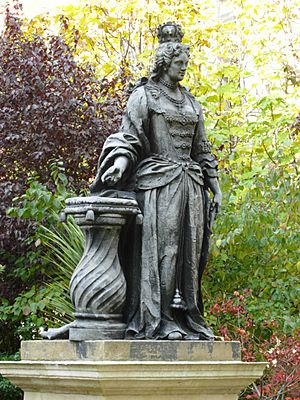Queen Square, London facts for kids
Queen Square is a lovely garden square located in the Bloomsbury area of central London. Many of the buildings around the square are connected to medicine, especially the study of the brain and nervous system, called neurology.
Contents
Building Queen Square: A Look Back in Time

Queen Square was built between 1716 and 1725. It was created from the large garden of a house that belonged to Sir John Cutler. His last child, Lady Radnor, passed away in 1697 without any children. The square was left open to the north, offering beautiful views of the hills of Hampstead and Highgate.
Queen Charlotte and King George III's Story
There is a statue in the square that people once thought was Queen Anne. However, experts now believe it shows Queen Charlotte.
Queen Charlotte's husband, King George III, received treatment for a mental illness in a house on Queen Square. This happened towards the end of his time as king. There's a story that the pub on the southwest corner, called "the Queen’s Larder," was used by Queen Charlotte. Legend says she stored food there for the king while he was getting better.
The church, named after St George the Martyr, was built in 1706. People donated money to help build it. A famous historian named William Stukeley was the church's leader from 1747 to 1765. His home was right next to the house of the duke of Powis.
Queen Square in the 1800s
Queen Square was built in the early 1700s as a trendy place to live. But by the mid-1800s, it had changed. Many French refugees moved there, and you could find shops selling books and prints. It also became a popular spot for charities. These included the Roman Catholic Aged Poor Society and the Society of St Vincent de Paul.
Over time, the big houses in the square became hospitals and other important places. The first medical place that is still there today was started by Johanna Chandler in 1860. In 1864, Elizabeth Malleson opened the Working Women's College here.
The College of Preceptors, also known as the College of Teachers, was located at No. 42 Queen Square from 1855 to 1887.
In 1861, a special bathhouse for women opened at No. 26. It was called the Ladies' True Turkish Bath. This was just one year after the first Victorian Turkish bath opened in London. It was the only one in London open daily just for women. It stayed open until 1865, and during that time, over 37,000 baths were taken!
Queen Square Today: A Hub for Health
Many buildings around Queen Square are now used for health care. They help with treating patients, doing research, and managing health services. Two hospitals are on the east side of the square. These are the National Hospital for Neurology and Neurosurgery (NHNN) and the Royal London Hospital for Integrated Medicine. People often just call the NHNN "Queen Square."
The Institute of Neurology, which is part of University College London (UCL), is in the northeast corner. The building that used to be the Institute for Public Health is now the main office for the NHNN and the Institute of Neurology.
Several buildings on the west side of the square are used for medical research. They are part of the Institute of Neurology and other UCL departments. For example, Alexandra House at number 17 is home to the UCL Institute of Cognitive Neuroscience. The Wellcome Trust Centre for Neuroimaging is at number 12. Numbers 8–11, called the Sir Charles Symonds House, have the Dementia Research Centre and the Centre for Neuromuscular Diseases.
At the south end of the square, you'll find the church we talked about earlier. There's also the Mary Ward Centre for adult education. The building that used to be the Italian Hospital is now part of Great Ormond Street Hospital for children. This famous children's hospital has its main buildings nearby.
Number 42-3, an old 18th-century house, has a long history of being used for education. It was home to the Royal Female School of Art from 1861. Later, it became the London County Council Trade School for Girls and the Technical College for Women. The Stanhope Institute for adult education used it in the 1950s. Finally, the Mary Ward Centre moved into the building in 1982.
A women-only Victorian-style Turkish bath was also located here. It was part of the Imperial Hotel's Turkish baths and had its own entrance on Queen Square from 1930 to 1962. The new Imperial Hotel still stands on this site today.
One building, the Sobell Department, has a lecture hall. UCL uses it for teaching students who are studying for advanced degrees. It has 220 seats, making it one of the largest lecture halls in Queen Square. Many famous scientists, like John Hardy, have spoken there.
Famous People Who Lived Here
Many interesting people have lived in Queen Square over the years:
- Edward Arber, a scholar who studied literature, and his son E.A.N. Arber, a botanist, lived at No. 5 in the 1870s.
- Sir William Browne, a doctor, lived here from 1749 to 1774.
- Fanny Burney, a famous novelist, lived here from 1770 to 1774.
- Frances Reynolds, a painter, lived here from 1792 to 1807.
- Francis Ronalds, an inventor, lived here from 1820 to 1822.
- Frederick Denison Maurice, a theologian and founder of The Working Men's College, lived at No. 5 and No. 21.



